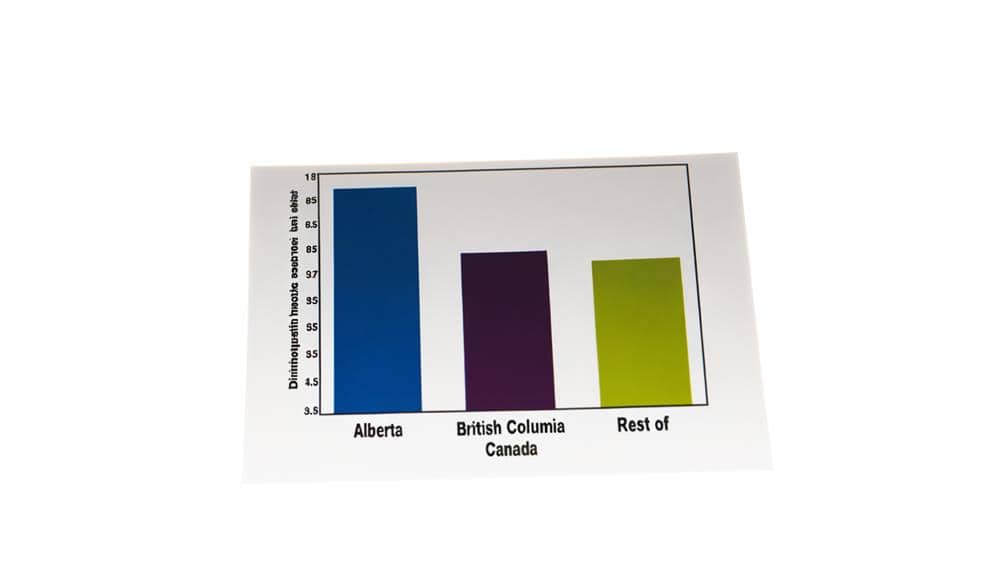
In recent years, statistical data has indicated intriguing trends in the divorce rates and related demographics for Alberta and British Columbia, compared to the rest of Canada. The nuances of these trends bear exploration, as they may disclose important insights into the societal, economic, and personal factors that influence the stability of marriages within these geographically varied regions.
As we initiate this analytical journey, one may wonder: what unique revelations about the Canadian social fabric will these statistics yield?
Key Takeaways
- Alberta’s divorce rate is slightly below the national average at 8.4 per 1,000 married individuals.
- British Columbia’s divorce rate surpasses the national average, standing at 10.3 per 1,000 married individuals.
- Both Alberta and British Columbia have consistently seen an increase in divorce rates over the past decade.
- Factors such as financial stress and cost of living contribute to the varying divorce rates in Alberta and British Columbia.
Divorce Rate in Canada
In an analysis of the divorce rate in Canada, recent data from Statistics Canada reveals that out of 38,246,108 individuals aged over 15 in 2021, approximately 2.74 million had experienced a divorce and had not remarried, marking a slow but consistent increase since 2000. This figure takes into account those living in common-law unions. The growth rate over 2020 is recorded to be approximately 1.03%, translating to an increase of about 28,425 individuals.
When the dataset is refined to exclude common-law couples, the total number of divorced individuals in 2021 decreases to 1,986,825, while the annual increase grows slightly to 1.15%. The growth from 2017 to 2021, marked at 5.45%, further highlights the steady rise in divorce rates.
However, the number of married individuals has also been increasing, albeit at a slower pace. The period from 2017 to 2021 saw a modest increase of 2.39%. This data suggests that while there may be a small decline in the rate of marriage, the rate of divorce continues to outpace it. This highlights a shift in societal norms and attitudes towards marriage and divorce.
| Geography7, 8 | Canada (map) | ||||
|---|---|---|---|---|---|
| Indicator9 | 2016 | 2017 | 2018 | 2019 | 2020 |
| Number | |||||
| Number of divorces | 62,397 | 62,256 | 61,344 | 56,937 | 42,933 |
| Rates per 1,000 population | |||||
| Crude divorce rate10 | 1.728 | 1.704 | 1.655 | 1.514 | 1.129 |
| Rate per 1,000 married persons | |||||
| Divorce rate11 | 8.6 | 8.5 | 8.2 | 7.5 | 5.6 |
| Age-standardized divorce rate12 | 10.4 | 10.3 | 10.0 | 9.1 | 6.8 |
| Rate per 1,000 marriages | |||||
| 30-year total divorce rate13 | 366.0 | 366.1 | 362.2 | 338.0 | 256.3 |
| 50-year total divorce rate14 | 399.4 | 400.1 | 396.3 | 369.4 | 279.7 |
| Years | |||||
| Mean duration of marriage15 | 15.6 | 15.6 | 15.6 | 15.5 | 15.3 |
| Median duration of marriage15 | 13.4 | 13.3 | 13.2 | 13.2 | 12.8 |
| Months | |||||
| Median duration of divorce proceedings16 | 5.4 | 5.1 | 4.8 | 4.9 | 5.8 |
| Percent | |||||
| Proportion of divorce applications that are filed jointly17 | 25 | 29 | 29 | 30 | 31 |
Divorce Rate and Other Stats for Alberta and BC
Shifting our focus to a regional level, we can examine how the divorce trends in Alberta and British Columbia compare to the overall Canadian statistics discussed previously. Both provinces exhibit distinctive patterns that warrant closer investigation.
Number of divorced people in Canada 2000-2022
Published by Statista Research Department, Feb 16, 2024
In 2022, there were about 2.78 million people who had obtained a legal divorce and not remarried in Canada. This figure has been steadily increasing since 2000, when there were about 1.88 million divorcees in Canada.
In Alberta, the divorce rate has consistently been slightly below the national average. This is an interesting anomaly, given that Alberta’s urbanization and income levels mirror those of the country at large.
British Columbia, on the other hand, has a higher divorce rate than the national average. This could potentially be attributed to the higher cost of living, which tends to stress marital relationships.
To paint a clearer picture, consider the following:
- Alberta’s divorce rate is approximately 8.4 per 1,000 married individuals, while the national average is around 8.7.
- British Columbia’s divorce rate is approximately 10.3 per 1,000 married individuals, higher than the national average.
- Both provinces have seen a steady increase in the number of divorces over the past decade, aligning with the national trend.
These figures underscore the importance of examining regional disparities when analyzing national divorce trends. By doing so, we can gain a more nuanced understanding of the factors influencing divorce rates in Canada.
Previous to 2020 our Divorce Rate was declining
| 1991 to 1995 | 2016 to 2020 | |
|---|---|---|
| number of persons who divorced per 1,000 married persons | number of persons who divorced per 1,000 married persons | |
| Canada | 12.8 | 7.7 |
| Newfoundland and Labrador | 7.9 | 6.2 |
| Prince Edward Island | 8.8 | 6.6 |
| Nova Scotia | 11.3 | 7.3 |
| New Brunswick | 9.4 | 7.4 |
| Quebec | 14.3 | 8.0 |
| Ontario | 12.2 | 7.2 |
| Manitoba | 11.4 | 7.1 |
| Saskatchewan | 10.6 | 7.7 |
| Alberta | 14.1 | 9.7 |
| British Columbia | 14.2 | 7.5 |
| Yukon | 17.7 | 12.8 |
| Northwest Territories1 | 11.0 | 7.5 |
| Nunavut1 | 11.0 | 2.4 |
Source(s): Canadian Vital Statistics – Divorce Database (3235).
Background: Divorce in Canada
To appreciate the regional divorce trends in Alberta and British Columbia, it is essential to understand the broader context of divorce laws and practices in Canada. The advent of the Divorce Act in 1968 streamlined the process, making it easier and more affordable. The Act has undergone changes over the years, the most significant being the reduction of the mandatory separation period from three years to one in 1986.
The Act established marriage breakdown as the sole grounds for divorce, effectively making Canadian divorces no-fault. To demonstrate marriage breakdown, one could show they’ve lived apart from their spouse for at least a year, or there’s evidence of cruelty or adultery. However, eligibility for divorce is subject to certain stipulations. At least one of the parties must be a resident of the province where the divorce application is lodged, and the marriage must have been legal under Canadian law or recognized by Canada.
Despite these simplifications, divorce in Canada remains a complex process, necessitating legal assistance. With a crude divorce rate of 2.1 (out of 1000 people), Canada ranks 26th among 107 surveyed countries.
Reasons for Divorces in Canada
Understanding the reasons for divorce in Canada provides a deeper insight into the societal and personal factors influencing marital breakdowns in the country. In an analytical view, the dominant cause of divorce in the country, accounting for 94.78% of cases, is no-fault separation, where couples live apart for at least a year to demonstrate marital breakdown.
Other reasons cited include adultery (3%), mental cruelty (1.2%), and physical cruelty (0.8%). These figures present a stark image of the state of marriages in Canada, with the majority of divorces caused by an irreparable breakdown in the relationship, rather than explicit acts of misconduct.
A 2014 Bank of Montreal poll further detailed the causes of marital breakdowns:
- Money issues (68%)
- Infidelity (60%)
- Family disagreements (36%)
These statistics suggest that financial issues and disagreements, infidelity, and family disputes are significant factors leading to divorce in Canada. Further research might shed light on the intricate dynamics of these factors and how they interact in the context of marriage, contributing to its breakdown.
Overall, understanding these reasons is essential to identifying trends and implementing strategies to support healthier marriages and mitigate divorce rates.
Divorce Rates by Age Group
Statistics Canada’s data from 2016 to 2020 reveals intriguing trends in divorce rates across different age groups in Canada, with a significant increase in ‘grey divorce’ and a distinct decrease among couples under the age of 50. A detailed examination of the data shows that the divorce rates remain highest for the age group 40 to 44, while the lowest rates fall among the categories below 25 and above 50.
Bear in mind that this data is prior to 2020. New data is showing a rise in all divorce rates.
| Geography7, 8, 9 | Canada (map) | ||||
|---|---|---|---|---|---|
| Sex or gender10 | Both sexes | ||||
| Indicator11 | Divorce rate12 | ||||
| Age at divorce13 | 2016 | 2017 | 2018 | 2019 | 2020 |
| Rate per 1,000 married persons | |||||
| All ages | 8.6 | 8.5 | 8.2 | 7.5 | 5.6 |
| Under 20 years | 5.5 | 3.3 | 3.2 | 2.1 | 2.1 |
| 20 to 24 years | 11.4 | 11.6 | 11.0 | 10.7 | 9.0 |
| 25 to 29 years | 13.5 | 12.9 | 12.9 | 11.1 | 8.5 |
| 30 to 34 years | 13.7 | 13.2 | 12.7 | 11.5 | 8.6 |
| 35 to 39 years | 13.8 | 13.7 | 13.0 | 11.6 | 8.6 |
| 40 to 44 years | 13.9 | 13.7 | 13.1 | 12.0 | 8.9 |
| 45 to 49 years | 12.9 | 12.9 | 12.7 | 11.8 | 8.8 |
| 50 to 54 years | 10.5 | 10.5 | 10.4 | 9.8 | 7.4 |
| 55 to 59 years | 7.2 | 7.2 | 7.3 | 6.8 | 5.2 |
| 60 to 64 years | 4.4 | 4.6 | 4.4 | 4.3 | 3.1 |
| 65 years and over | 1.7 | 1.7 | 1.7 | 1.6 | 1.2 |
Statistics Canada. Table 39-10-0053-01 Number of persons who divorced in a given year and divorce rate per 1,000 married persons, by age group and sex or gender
DOI: https://doi.org/10.25318/3910005301-eng
The downward trend is more pronounced for younger couples. Importantly, the decline for the age group 40-44 from 2016 to 2020 is 36%, whereas the decrease for the age group 55-59 for the same period is only 27.7%. This suggests that more Canadians are divorcing later in life, a trend that may be influenced by shifts towards later marriage and the rise of common-law relationships. The data offers a compelling insight into the changing dynamics of marital dissolution in contemporary Canada.
New Relationships After Separation
While the rate of divorces among various age groups provides a picture of marital dissolution in Canada, it is equally insightful to contemplate the patterns that emerge following separation, particularly the time it takes for individuals to start on new relationships.
In the 35 to 64 age bracket, the average time before entering a new relationship post-separation is 4.5 years for men and 4.8 years for women. This reveals a relatively short adjustment period before individuals seek companionship again. There is also a significant proportion (26%) of relationships that are second or subsequent unions, indicating resilience in the pursuit of partnership.
- More than a quarter of individuals in a marriage or common-law union are in their second or subsequent relationship.
- Of those in subsequent relationships, 36% are common-law, with many marriages (46%) beginning in such a union.
- Individuals in subsequent relationships tend to remain together for over a decade, with a substantial number having children with their current partner.
These patterns demonstrate that many Canadians continue to seek and maintain long-term partnerships despite divorce or separation, with a noticeable trend towards common-law unions. The resilience and adaptability of individuals maneuvering the complexities of relationships post-separation are evident in these statistics.
What raises the odds of you having a divorce?
Several factors greatly amplify the probability of a marriage ending in divorce, ranging from age at marriage to education level and even the division of household chores. Younger couples and those who marry later, after the age of 32, face higher divorce risks as do those entering a second marriage. The stress of major life changes may also increase the likelihood of separation.
Education level plays a significant role, with a higher likelihood of divorce among those who did not finish high school. Financial stressors are a common trigger for marital strife, often leading to divorce. The distribution of household chores can similarly influence the stability of the marriage, with imbalance possibly leading to resentment and conflict.
Behavioural aspects such as contempt, persistent criticism, withdrawal during the conflict, and negative language about the marriage can all elevate the risk of divorce. Interestingly, excessive affection in the early stages of marriage may also indicate underlying issues, potentially serving as a predictor of future separation. Understanding these factors can help mitigate the risks and promote healthier, more sustainable relationships.
Did COVID-19 Impact Divorce Rates in Alberta Compared to the Rest of Canada?
The COVID-19 pandemic brought significant shifts to family dynamics, impacting divorce rates in Alberta and across Canada. In this evolving landscape, “alberta child support” became an essential focus for separated parents, ensuring financial stability for children amid rising uncertainties and changing legal demands shaped by the unprecedented challenges of the global health crisis.
Do Polygamy Laws Impact Divorce Rates in Alberta, BC, and the Rest of Canada?
Polygamy laws and loopholes in canada play a complex role in shaping societal dynamics, potentially influencing divorce rates. In provinces like Alberta and BC, the legal ambiguity around such practices may affect relationship stability. These loopholes can create challenges in enforcing marriage laws, indirectly impacting family structures and marriages across the nation.
How Do Alberta’s Divorce Rates Compare When Couples Remarry the Same Person?
Remarrying after divorce in alberta can present unique dynamics for couples, potentially influencing divorce rates differently than first marriages. Studies suggest that when couples decide to remarry the same person, previous experiences might strengthen the bond or, conversely, highlight unresolved issues, impacting Alberta’s overall divorce trends in remarriages specifically.
What Does This Data Tell Us?
Analyzing the aforementioned factors and their implications, it becomes clear that the decreasing trend in divorce rates should not necessarily be equated with a reduction in marital conflict or the elimination of divorce risks. The data suggests that while fewer couples may be divorcing, this does not indicate an absence of marital strife or a guarantee of marital longevity. Instead, it may be indicative of growing caution and preparation among couples, as evidenced by an increase in prenuptial and postnuptial agreements.
The following points can be inferred from the data:
- A decline in divorce rates might be partially attributed to couples being more selective and getting married later in life.
- There is an increasing trend of couples signing prenuptial and postnuptial agreements, which can serve to safeguard both parties in case of a divorce financially.
- Such agreements can protect premarital assets and businesses, but cannot predetermine matters of child custody or support.
This data reflects not an elimination of divorce risk, but perhaps a shift in societal attitudes towards a more pragmatic approach to marriage and divorce.
Spectrum Family Law can Help
In handling the intricacies of prenuptial and postnuptial agreements, divorce, separation, and related matters, Spectrum Family Law stands as a reliable ally, ready to provide expert legal assistance and guidance. Their team of experienced lawyers understands that these issues can be emotionally draining and legally challenging. They offer a thorough, solution-focused approach, specifically tailored to the unique needs of each client.
| Services Offered by Spectrum Family Law | Why Choose Spectrum Family Law |
|---|---|
| Expert advice on prenuptial, and postnuptial agreements | Proven track record in handling complex family law cases |
| Thorough divorce and separation guidance | Personalized, empathetic approach to each client’s situation |
| Child custody and spousal support issues | Extensive experience and knowledge in family law |
Spectrum Family Law’s expertise extends beyond the basics. They also handle child custody, spousal support, property division, and other related matters. They are committed to providing their clients with the highest level of service, ensuring their rights are protected throughout the process. Their wealth of experience and dedication to client satisfaction make them a top choice for individuals dealing with the complexities of family law. With Spectrum Family Law, clients can expect compassionate, expert legal guidance that will help them through their unique situation.

We currently have three offices across Alberta — Edmonton, Calgary, and Red Deer. We serve the entire province of Alberta (and BC). We also have the infrastructure to work with any of our clients virtually — even the furthest regions of Alberta.
Call 1 (855) 892-0646 (toll free) to get routed to the best office for you or contact us online for general inquiries.
We also have a dedicated intake form to help you get the ball rolling. Our intake team will review your specific case and advise you on the next steps to take as well as what to expect moving forward. That’s the best way to schedule an appointment

Our offices are generally open 8:30 a.m.—4:30 p.m., Mon—Fri.

Our main hub for British Columbia is located in the heart of Vancouver. That said, we serve the entire province of BC. We have the infrastructure to work with any of our clients virtually — even the furthest regions of British Columbia.
Call 778-452-0221 [toll free 1 (877) 402-1004] to get routed to the best representative to serve you or contact us online for general inquiries.
We also have a dedicated intake form to help you get the ball rolling. Our intake team will review your specific case and advise you on the next steps to take as well as what to expect moving forward. That’s the best way to schedule an appointment

Our offices are generally open 8:30 a.m.—4:30 p.m., Mon—Fri.


Shantale D’Aoust
FAMILY LAWYER
Shantale has vast advocacy and litigation experience. She strives to help her clients navigate through their legal issues by assessing risks to provide practical options so they can take back control of their lives.
The Legal Review Process by Spectrum Family Law
- Spectrum strives for high-quality, legally verified content.
- Content is meticulously researched and reviewed by our legal writers/proofers (usually local law students).
- Details are sourced from trusted legal sources like the Family Law Act.
- Each article is edited for accuracy, clarity, and relevance.
- If you find any incorrect information or discrepancies in legal facts, we kindly ask that you contact us with a correction to ensure accuracy.


